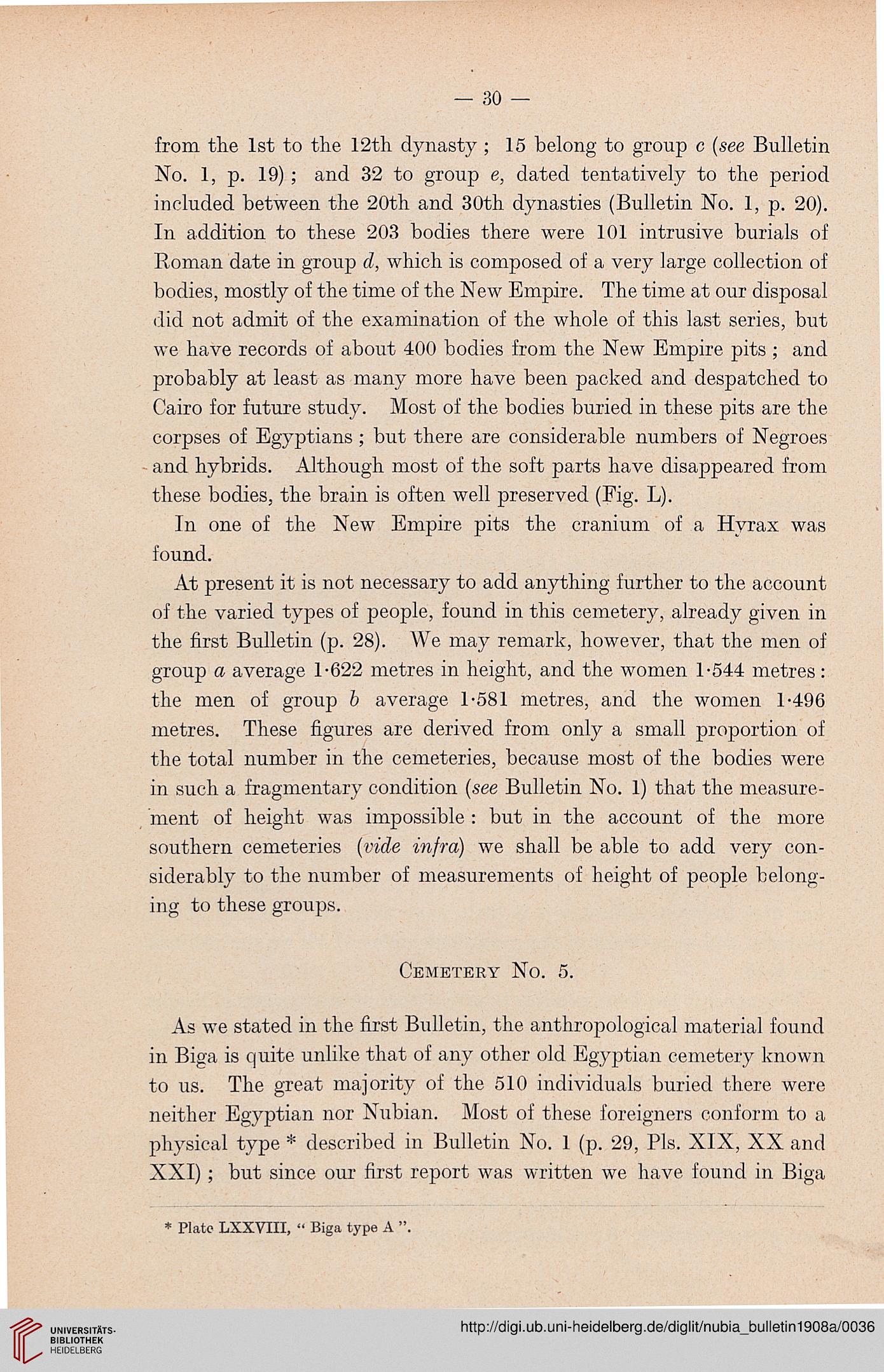— 30 —
from the 1st to the 12th dynasty ; 15 belong to group c (see Bulletin
No. 1, p. 19) ; and 32 to group e, dated tentatively to the period
included between the 20th and 30th dynasties (Bulletin No. 1, p. 20).
In addition to these 203 bodies there were 101 intrusive burials of
Roman date in group d, which is composed of a very large collection of
bodies, mostly of the time of the New Empire. The time at our disposal
did not admit of the examination of the whole of this last series, but
we have records of about 400 bodies from the New Empire pits ; and
probably at least as many more have been packed and despatched to
Cairo for future study. Most of the bodies buried in these pits are the
corpses of Egyptians ; but there are considerable numbers of Negroes
and hybrids. Although most of the soft parts have disappeared from
these bodies, the brain is often well preserved (Fig. L).
In one of the New Empire pits the cranium of a Hyrax was
found.
At present it is not necessary to add anything further to the account
of the varied types of people, found in this cemetery, already given in
the first Bulletin (p. 28). We may remark, however, that the men of
group a average 1-622 metres in height, and the women 1-544 metres:
the men of group b average 1-581 metres, and the women 1-496
metres. These figures are derived from only a small proportion of
the total number in the cemeteries, because most of the bodies were
in such a fragmentary condition (see Bulletin No. 1) that the measure-
ment of height was impossible : but in the account of the more
southern cemeteries (vide infra) we shall be able to add very con-
siderably to the number of measurements of height of people belong-
ing to these groups.
Cemetery No. 5.
As we stated in the first Bulletin, the anthropological material found
in Biga is quite unlike that of any other old Egyptian cemetery known
to us. The great majority of the 510 individuals buried there were
neither Egyptian nor Nubian. Most of these foreigners conform to a
physical type * described in Bulletin No. 1 (p. 29, Pis. XIX, XX and
XXI); but since our first report was written we have found in Biga
* Plate LXXVIII, " Biga type a ".
from the 1st to the 12th dynasty ; 15 belong to group c (see Bulletin
No. 1, p. 19) ; and 32 to group e, dated tentatively to the period
included between the 20th and 30th dynasties (Bulletin No. 1, p. 20).
In addition to these 203 bodies there were 101 intrusive burials of
Roman date in group d, which is composed of a very large collection of
bodies, mostly of the time of the New Empire. The time at our disposal
did not admit of the examination of the whole of this last series, but
we have records of about 400 bodies from the New Empire pits ; and
probably at least as many more have been packed and despatched to
Cairo for future study. Most of the bodies buried in these pits are the
corpses of Egyptians ; but there are considerable numbers of Negroes
and hybrids. Although most of the soft parts have disappeared from
these bodies, the brain is often well preserved (Fig. L).
In one of the New Empire pits the cranium of a Hyrax was
found.
At present it is not necessary to add anything further to the account
of the varied types of people, found in this cemetery, already given in
the first Bulletin (p. 28). We may remark, however, that the men of
group a average 1-622 metres in height, and the women 1-544 metres:
the men of group b average 1-581 metres, and the women 1-496
metres. These figures are derived from only a small proportion of
the total number in the cemeteries, because most of the bodies were
in such a fragmentary condition (see Bulletin No. 1) that the measure-
ment of height was impossible : but in the account of the more
southern cemeteries (vide infra) we shall be able to add very con-
siderably to the number of measurements of height of people belong-
ing to these groups.
Cemetery No. 5.
As we stated in the first Bulletin, the anthropological material found
in Biga is quite unlike that of any other old Egyptian cemetery known
to us. The great majority of the 510 individuals buried there were
neither Egyptian nor Nubian. Most of these foreigners conform to a
physical type * described in Bulletin No. 1 (p. 29, Pis. XIX, XX and
XXI); but since our first report was written we have found in Biga
* Plate LXXVIII, " Biga type a ".




